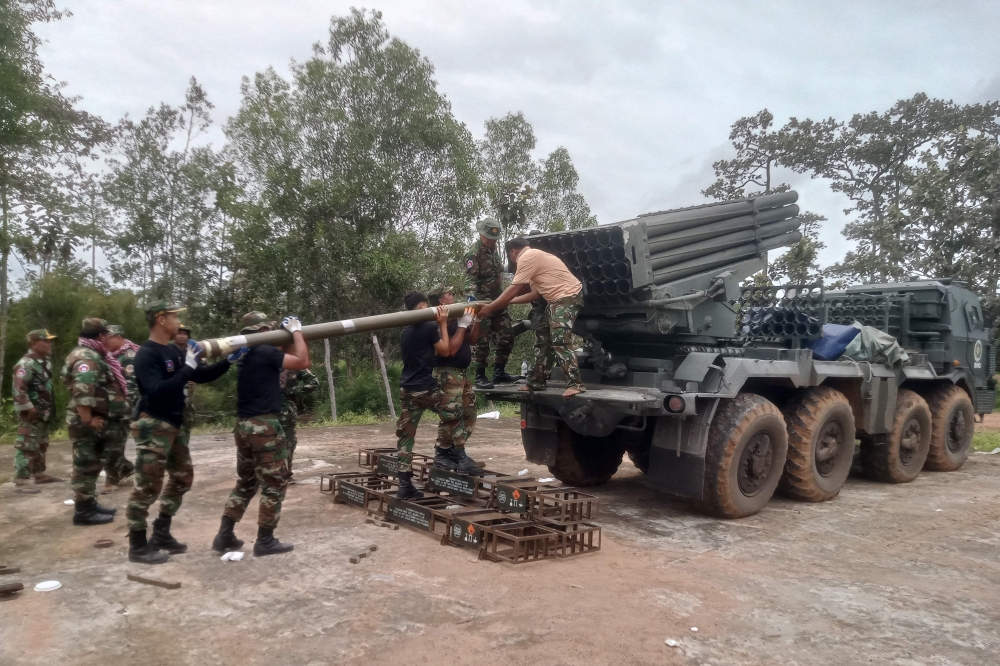JULY 31 — From co-ordinated drone attacks in the Ukraine-Russia conflict, to the explosion of walkie-talkies in the Middle East, the nature of modern warfare has changed dramatically. In the India-Pakistan conflict, Chinese-made weapons are stepping into the spotlight. In that clash, Pakistan used a well-coordinated system of Chinese equipment, from JF-17 fighter jets to radars and AWACS to check Indian advances. The highlight? Downing of an Indian Rafale jet.
This wasn’t just a parade of Chinese technology—it was a live demonstration that these systems could hold their own in a real fight.
Fast forward to the recent Thailand-Cambodia conflict, it is a different kind of conflict – lower in scale but rich in strategic nuance. After the peace deal in Putrajaya, experts have begun examining how this conflict compares to others, and what it reveals about regional power projection.
Over the past few decades, China has become a prominent arms supplier to countries in Southeast Asia, Africa, and the Middle East. Cambodia, an important and long standing China ally in Southeast Asia, has emerged as a key recipient. Other than small firearms, Its major inventory includes Type-59D tanks, SH-15 howitzers, BM-21 and RM-70 multiple launch rocket systems (MLRS).
Thailand also procures some Chinese platforms such as the VT-4 tanks and VN-16 amphibious vehicles, but it remains largely reliant on Western systems. In the skirmish with Cambodia, it was this Western edge that dominated its military response. The Royal Thai Armed Forces (RTAF) deployed F-16 fighter jets, Swedish-made JAS 39 Gripens, and Israeli ATMOS howitzers that offered a decisive technological and operational advantage.
In the skirmish, Cambodia’s military response was rooted in older Soviet-era and Chinese-supplied systems. Cambodia relied heavily on the use of BM-21 and RM-70 MLRS, indicating the strategic importance of the assets. These rocket systems, known for their saturation firepower but limited precision, may have been responsible for civilian casualties reported on the Thai side. In addition, the deployment of SH-15 howitzers by Cambodia looked primitive, as the absence of advanced targeting systems and coordinated ISR (Intelligence, Surveillance, Reconnaissance) support caused their efforts ineffective. While rumors of Cambodia acquiring the more advanced Chinese PHL-03 MLRS have surfaced, there has been no confirmed deployment in this conflict.
In contrast to the haphazard artillery tactic, lack of coordinated firepower actions from Cambodia, Thailand’s counter-offensive, designated Operation Yuttha Bodin, emphasized on precision and deterrence. RTAF has demonstrated carefully orchestrated strikes in the deployment of fighter aircraft, artillery, and drones. One notable drone attack successfully neutralized a Cambodian rocket launcher moments before it could fire.
In fact, the military strength of RTAF is underpinned not only by superior platforms but also extensive international training and exposure. For decades, RTAF has been no stranger to international land-centric exercises, such as Hanuman Guardian (with the US), Lightning Forge, Balance Torch, and Pitch Black (with Australia), which cement their readiness for real-world scenarios.
Exercise Cobra Gold, which is an annual multinational exercise organized by Thailand, is one of the most important occasions for the Royal Thai Air Force to enhance its capability with US and other forces. Through the exercise, Thailand’s F-16 and JAS 39 Gripen pilots sharpen their interoperability skills in realistic combat scenarios.

Cambodian soldiers reload the BM-21 multiple rocket launcher in Preah Vihear province on July 24, 2025 after Thailand launched air strikes that have resulted in civilian casualties. — AFP pic
In comparison to Thailand, Cambodia has limited participation in multilateral military exercises. It has only focused on joint training and defense cooperation such as the “Golden Dragon” exercise. These drills typically involve counterterrorism, humanitarian assistance, and disaster relief scenarios.
In this conflict, Thai F-16s and Gripens flew combat missions together in response to the offensive by MLRS from Cambodia. It is the first time both aircraft operated together in an actual combat environment to form a formidable strike package. Thailand chose not to respond to Cambodia’s MLRS attacks with a more powerful system like HIMARS, but instead with state-of-the-art aircrafts, is an excellent demonstration of coordinated air power, reflecting strategic emphasis on precision and escalation control.
Another standout capability demonstrated by the Thai Air Force was the use of KGGB (Korean GPS-Guided Bombs). These GPS/INS-guided munitions enabled high-precision strikes on Cambodian positions with minimal collateral damage.
Interestingly, there were no reports of GPS jamming or electronic signal disruption in these areas throughout the conflict, nor did these interferences reported in NOTAMs (Notice to Airmen), indicating either a serious lack of such capability or an unwillingness to escalate technologically from Cambodia.
The seamless deployment of KGGB highlights two key points: first, the depth of Thai-American and -South Korea defense collaboration, because P(Y) code or M-code of GPS is controlled by US; Secondly, Thailand’s integration into global GPS-reliant warfare, an electronic warfare domain where denial tactics could have shifted the balance.
Among recent global conflicts, like the brutal Russia-Ukraine war or the tightly managed Israel-Iran and Pakistan-India standoffs, the Thailand–Cambodia clash stood out for how low-tech and controlled it was. It felt like both sides were holding back, especially Thailand.
Despite being clearly more capable, Thailand responded with precision and restraint. Why?
Possibly because Cambodia is a key ally of China, and dragging in a superpower is the last thing anyone in Asean wants. The region highly values its ability to solve issues in its compound without inviting external interference. On top of that, this was a basic, conventional fight without electronic warfare, satellites, or cyber attacks, hence any escalation seemed unlikely from the start. Many suspect China sees Cambodia as a proxy, but in this case, Beijing remained conspicuously silent, suggesting that even China didn’t want this to spiral out of control.
Nobody would like to seek conflict, but in geopolitics, clashes are sometimes inevitable. What distinguishes responsible actors is how they manage them. Thailand’s response was deliberate and carefully calibrated, but it sent a message! Cambodia’s Chinese-made arsenal underperformed in both execution and effect. Whether this was due to inadequate training, poor command integration, or a deliberate decision to withhold capabilities remains unclear.
However, superiority lies not in hardware alone, but in how that hardware is wielded. Having weapons is just insufficient, the systems, the training, and the discipline to use them make a difference.
In a region where diplomacy still counts, this low-key yet firm clash reminded everyone that power can be shown without turning up the heat.
The Thai-Cambodia border may be quiet for now, but it could be temporary. Until the longstanding territorial disputes are formally resolved, the possibility of renewed tension lingers.
Cambodia really needs to have deep reflection during this period of time. Should it rethink its military doctrine? Should it strengthen its forces or focus on improving usage of current assets? Perhaps more importantly, can it broaden its defense partnerships beyond its traditional ally, China?
These are pressing questions for Phnom Penh that require both strategic clarity and diplomatic finesse, for regional stability.
* Phar Kim Beng is Professor of Asean Studies, Director of Institute of Internationalization and Asean Studies at the International Islamic University of Malaysia. Jitkai Chin is Associate Professor, Department of Chemical Engineering, Universiti Teknologi Petronas.
** This is the personal opinion of the writer or publication and does not necessarily represent the views of Malay Mail.






